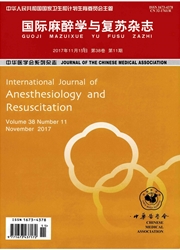

 中文摘要:
中文摘要:
目的 察鞘内注射酪氨酸激酶受体B(tyrosinekinasereceptorB,TrkB)抑制剂K252a对皮肤/肌肉切口牵拉术(skin/muscleincisionandretraction,SMIR)诱发的术后持续性痛大鼠脊髓背角钾氯共转运体-2(K+-CI—cotransporter2,KCC2)蛋白表达的影响。方法采用随机数字表法将52只成年雄性SD大鼠随机分成假手术组(对照组)、SMIR组、SMIR+-甲基亚砜(dimethylsulfoxide,DMSO)组和SMIR+K252a组,每组13只。于术前1d及术后3、7、12、22、32d测定大鼠机械缩足反射阈值(mechanicalwithdrawalthreshold,MWT),Westernblot测定术后7d大鼠脊髓背角KCC2蛋白的表达。结果与对照组比较,术后7、12、22d时MWT在sMIR组[(22.5±2.3)、(24.9±1.4)、(29.5±2.4)g]和SMIR+DMSO组[(24.0±1.9)、(24.8±2.3)、(26.7±2.1)g]明显降低(P<0.05);与SMIR组比较,术后7、12、22d时MWT在SMIR+K252a组[(31.6±1.7)、(36.1±2.0)、(38.1±2.1)g]明显上调(P〈0.05)。与对照组比较,术后7d时SMIR组和sMIR+DMS0组的脊髓背角KCC2表达明显下调(P〈0.05),SMIR+K252a组未检测到明显变化(P〉0.05)。与SMIR组比较,SMIR+K252a组的脊髓背角KCC2表达明显上调(P〈0.05)。结论脊髓背角KCC2的表达变化可能参与了大鼠术后持续性痛的形成。
 英文摘要:
英文摘要:
Objective To observe the effects of intrathecal injections of tyrosine kinase receptor B(TrkB) inhibitor K252a on K+-Cl- cotransporter 2 (KCC2) expression in the skin/muscle incision and retraction (SMIR)-induced persistent postoperative pain in rats. Methods Fifty two aduh male SD rats were randomly and equally divided into four groups, namely the sham group(control group), SMIR group, SMIR+dimethyl sulfoxide (DMSO) group and SMIR+K252a group. Mechanical withdrawal threshold (MWT) was measured at the preoperative day 1 and postoperative days 3, 7, 12, 22 and 32, and KCC2 expression in the spinal dorsal horn was detected at postoperative day 7 by western blot. Results Compared with sham group, the MWT decreased significantly at postoperative days 7, 12, 22 in SMIR group [(22.5:1:2.3), (24.9±1.4), (29.5±2.4) g] and SMIR+DMSO group [(24.0±1.9), (24.8±2.3), (26.7±2.1) g](P〈0.05). While compared with SMIR group, the MWT increased obviously at postoperative days 7, 12, 22 in SMIR+ K252a group [(31.6±1.7), (36.1±2.0), (38.1+2.1) g](P〈0.05). In addition, at postoperative days 7, compared with sham group, the expression of KCC2 in the spinal dorsal horn decreased significantly in SMIR group and SMIR+DMSO group (P〈0.05), and no statistical significance in SMIR+K252a group (P〉0.05). Compared with SMIR group, KCC2 expression in the spinal dorsal horn in SMIR+K252a group upregulated significantly (P〈0.05). Conclusions KCC2 variations in the spinal dorsal horn may participate inthe modulation of persistent postoperative pain evoked by SMIR in rats.
 同期刊论文项目
同期刊论文项目
 同项目期刊论文
同项目期刊论文
 The activation of spinal astrocytes contributes to preoperative anxiety-induced persistent post-oper
The activation of spinal astrocytes contributes to preoperative anxiety-induced persistent post-oper The Efficacy of NMDA receptor antagonists for preventing remifentanil-induced increase in postoperat
The Efficacy of NMDA receptor antagonists for preventing remifentanil-induced increase in postoperat Intrathecal injection of KN93 attenuates paradoxical remifentanil-induced postoperative hyperalgesia
Intrathecal injection of KN93 attenuates paradoxical remifentanil-induced postoperative hyperalgesia The Effect of NR2B Subunit Palmitoylation at the Spinal Level After Chronic Dorsal Root Ganglia Comp
The Effect of NR2B Subunit Palmitoylation at the Spinal Level After Chronic Dorsal Root Ganglia Comp Regulation of the NR2B-CREB-CRTC1 Signaling Pathway Contributes to Circadian Pain in Murine Model of
Regulation of the NR2B-CREB-CRTC1 Signaling Pathway Contributes to Circadian Pain in Murine Model of Intrathecal administration of roscovitine prevents remifentanil-induced postoperative hyperalgesia a
Intrathecal administration of roscovitine prevents remifentanil-induced postoperative hyperalgesia a Intrathecal Injection of JWH015 Attenuates Remifentanil-Induced Postoperative Hyperalgesia by Inhibi
Intrathecal Injection of JWH015 Attenuates Remifentanil-Induced Postoperative Hyperalgesia by Inhibi The inhibitor of calcium/calmodulin-dependent protein kinase II KN93 attenuates bone cancer pain via
The inhibitor of calcium/calmodulin-dependent protein kinase II KN93 attenuates bone cancer pain via Neuron-restrictive silencer factor in periaqueductal gray contributes to remifentanil-induced postop
Neuron-restrictive silencer factor in periaqueductal gray contributes to remifentanil-induced postop The cyclic AMP response element-binding protein antisense oligonucleotide induced anti-nociception a
The cyclic AMP response element-binding protein antisense oligonucleotide induced anti-nociception a 期刊信息
期刊信息
